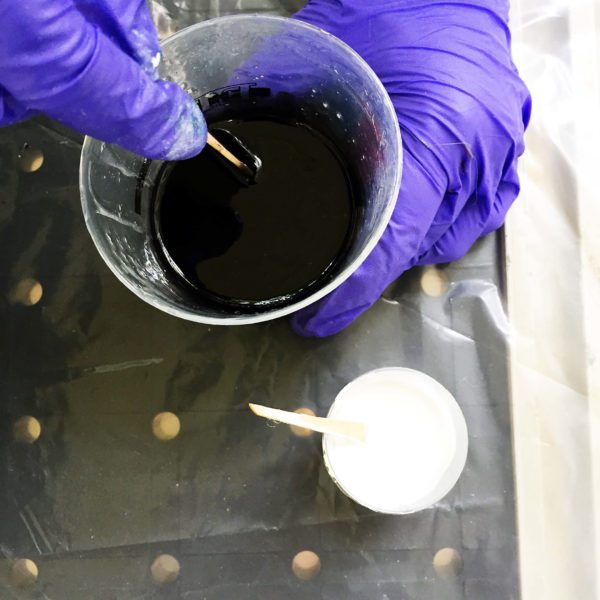You’ve seen beautiful geode coasters. Or you’re drooling over the idea of bespoke paperweights. And now you’re wondering how to use resin so you can make these amazing crafts too.
So you start researching things like
*What resin supplies to buy?
*What details should beginners know?
and most importantly…
*How do you get things right the first time? And the second time. And the umpteenth time.
(Because the holy grail of learning how to use resin is to do it without making sticky, bubble-filled messes.)
So let’s start here…
How does it work?
A chemical reaction turns the liquid to a solid. With two-part resins, this happens when you mix Part A with Part B. With UV resins, curing occurs when you expose the liquid to UV light.
How do you mix resin?
They don’t all mix the same.
Your kit instructions will tell you how much of each liquid to mix together (in the case of two-part kits) and will tell you how long you have to use it before it starts to gel or harden.
💡 Pro tip: As you’re mixing the liquids together, scrape the sides of your cup and mixing utensil several times during the process. If you’re a baker, it’s like scraping the sides of your mixing bowl with a rubber spatula. Poorly mixed resin is the biggest reason it cures sticky.
How do you know which one to use?
Choosing the best resin for your project comes down to ONE QUESTION:
Are you pouring resin into a space or coating a surface?
If you’re pouring it into a space, you want a casting resin. These are designed to fill molds and table voids while curing bubble-free. You can also pour them in thick layers.
Best for small molds
Resin Obsession super clear resin
You can mix between ½ ounce and 3 ounces at once
It cures hard and crystal-clear in 8 to 12 hours
You’ll get top-level UV protectants to guard against yellowing
Best for large molds and river tables
Resin Obsession deep pour epoxy resin
You can mix between 3 ounces and 3 gallons AND pour up to two inches thick at once
It’s a slow-curing formula to prevent cracking and shrinkage
You’ll get UV protectants to keep your resin clear
If you’re using it to coat a surface, you want a doming resin. These are designed for surface coatings, avoiding voids and fish eyes. Plus, they finish with a raised, smooth coating.
Best for coating surfaces with a clear, glossy finish
Resin Obsession crystal doming resin
You can mix between 1 ounce and 1 gallon at once
It stays fluid for 30 to 50 minutes to give you plenty of time to apply to a surface
It has our best level UV protectants
Best for coating a surface with colors
Resin Obsession artwork resin
You can mix 3 ounces to 1 gallon at once
It’s an economical choice when needing large volumes of resin
The resin locks in colors so they won’t fade.
What other supplies do you need?
Regardless of what you’re making, these supplies are essential:
• Gloves to protect your hands
• Wax paper or a silicone mat to protect your surface
• Mixing cups
• Stirring sticks
Optional supplies:
• Colors
• Molds
• Jewelry blanks
• Mold release
• Heat gun
For a downloadable list of what you need, check out this beginner supply checklist.
Here are a few of our customers’ favorite molds:
What about using silicone molds meant for food?
Yes, you can use these. But…
They almost always require extra finishing to get a shiny surface. And once you use them for art projects, don’t use them with food again.
What if you don’t want to use a mold?
You don’t have to.
This is where you can use a doming epoxy to coat a surface. Quickly make jewelry without molds or give a drink tumbler a glossy finish.
How do you make something unique?
That’s where inclusions and found items come in. Here are a few of my favorites: glitter, charms, candy sprinkles, glass beads, and stickers.
⭐️ BONUS: Here are ten of my favorite things to include.
But you can’t use anything you find. Here are five things you should never set in resin.
How can you color it?
You’re going to get the best results by using colors designed for resin.
Why?
These are tested for color stability to make sure you don’t experience any curing issues.
Is there anything you shouldn’t use?
While you may see other crafters using acrylic paint, it’s not the best. It can make your project cure rubbery. Nail polish doesn’t work great, either.
If you want to learn more, this article dives deep into how to color clear epoxy.
What’s the fastest way to learn how to use resin?
Try one of our all-in-one beginner kits. They contain the basic supplies to let you get started the same day you get the kit.
Buy our beginner kit to learn casting
This beginner kit comes with a super clear epoxy 6-ounce kit, a coaster mold, measuring cups, mixing utensils, and gloves.
Buy our beginner kit to make jewelry in bezels
This beginner kit comes with a crystal doming epoxy 8-ounce kit, twenty jewelry blanks, mixing supplies, and gloves.
And you’ll save money when buying either kit over purchasing the supplies separately.
Want to learn more about how to use resin?
Then you’ll want to get the ebook, Resin Fundamentals. I’ve taken my seventeen years of experience and condensed it into a PDF book of the essentials beginners need to know to have success from day one. Buy the book now, and you’ll have it to download in minutes.
Unpublished Blog Posts of Resin Obsession, LLC © 2023 Resin Obsession, LLC







I DO NOT LIKE PART OF YOUR INFORMATION COME IN ‘FOLLOW IT’.
I’m not clear on what’s going on Ann. Tell me more…